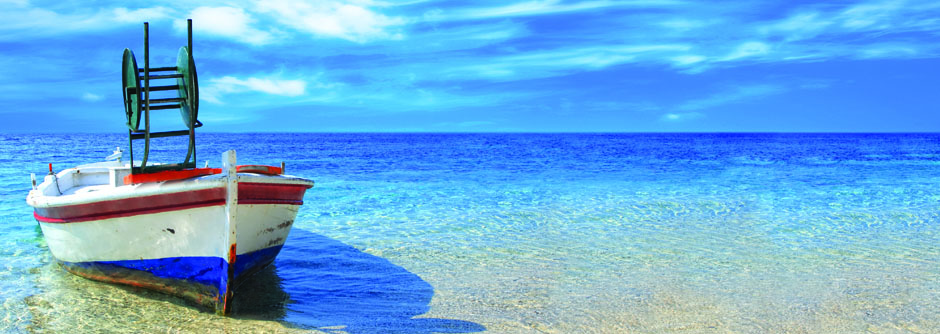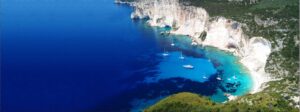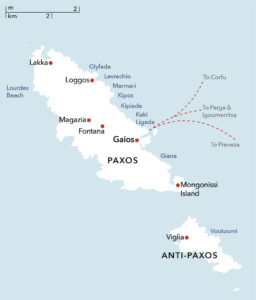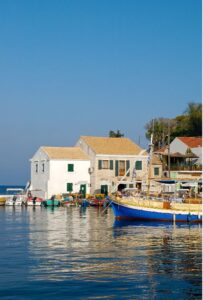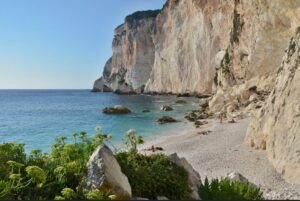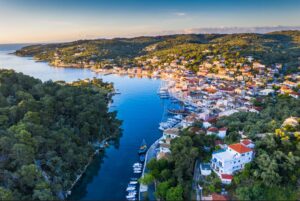Paxos the island where the emerald green meets azure blue, an island of colours!
…………Whether you’re ambling through an olive grove or enjoying lunch at a waterside taverna in a little fishing village, you can sure rely on a daily dose of real Greek culture on a holiday to the perfect island of Paxos.
This little Greek island measures just 10 x 4 kilometres, not big enough to host its own airport so that’s certainly halted any mass development on the island. As a result, Paxos attracts travellers from all over the world who come to explore this delightful island and why not, with a coastline awash with secluded pebble bays and coves, and an interior covered with some of the oldest olive groves in Greece. It’s truly spectacular!
Its population is approximately 2,500 people, most living in the waterside towns of Gaios, Loggos & Lakka but of course numbers increase during the hot summer months.
The capital Gaios is the busiest of them all with visitors mingling with islanders going about their daily life much of which is around the waterfront and the pretty Venetian Square. Some five kilometres along the coast we find Loggos, where the crescent-shaped waterfront is lined with tavernas, serving traditional Greek meze dishes for you to choose.
Lakka is the northern port of Paxos with its sheltered horseshoe shaped bay guarded by centuries old olive & cypress trees. Paxos is a perfect destination for lovers of beach life and for those who love swimming in crystal clear turquoise waters.
The east coast is home to numerous shingle and pebbly coves with good access and family-friendly beaches, while the much more rugged west coast offers dramatic cliffs and more off-the-beaten track bays requiring some walking.
EXPLORING PAXOS
Let’s take a brief look at the island’s history.
The people who tend the olive groves have generations of experience, meaning that the Paxos olive trees are the most pampered in the world. They produce a connoisseur’s oil, golden smooth and mellow. Not for these trees is the annual back and sides of a severe pruning. They are allowed to grow more or less unrestrained. What’s good for the olives is also good for the islanders and their visitors, for Paxos is as much an island of dappled shade, cool glades, and peaceful woodland walks as of beaches, hidden coves and wild cliffs.
Visitors have been coming to the island since ancient times, most of them uninvited, until the development of tourism in the latter half of the 20th Century. Somehow the island seems to have avoided much of the bloodshed and strife of its larger neighbours. Anthony and Cleopatra allegedly enjoyed a final romantic meal together on the island before the fateful Battle of Actium in 31BC, candlelit of course, with water lapping against the sides of their quinquereme and the moon silvering the waves!
Since the end of World War II, Paxos’ reputation as a peaceful holiday paradise has struck a chord with the British and once visited appears to inspire a lifelong devotion. There is one family who come to the island every year and are now well into the fourth generation.
The villages of the island are intriguing. Gaios, is considered the gateway to Paxos and its harbour is spectacularly disguised from the sea by the small island of Agios Nikolaos, inhabited only by the local priests. Once around this most holy of islands, the harbour of Gaios opens up magnificently to reveal the waterfront and the patchwork of alleyways and tavernas. Further up the coast one will find Loggos, a picturesque traditional Greek fishing village.
Sleepy by nature, Loggos is a tranquil retreat with four tavernas, a bakery and a mini market. Close by, after a short stroll through the olive trees, you will stumble across the excellent peaceful beaches of Levrechio, Marmari, Kipos and Glyfada – all with white pebbles and crystal clear aqua blue waters. Inland you will find the village of Magazia, a village with tavernas and a mini market set amongst the deepest of olive groves at the crossroads of all the inland lanes that wind round the island.
Paxos has avoided all forms of mass tourism, and whilst Gaios, the capital, and to a lesser extent the smaller villages of Lakka and Loggos, buzz with a cosmopolitan mix of yachtsmen and day visitors from Corfu. Very few people stray further afield. Even in the middle of August, one can wander along any of the hu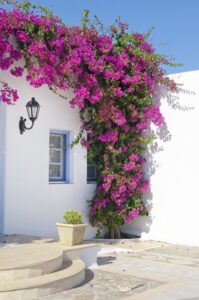 ndreds of paths and rarely meet a soul.
ndreds of paths and rarely meet a soul.
With no large hotel complexes, villas and apartments that are mostly set by themselves amongst the olives, the island can never become overcrowded – allowing the native islanders and their seasonal visitors to get to know each other. This is by no means an island whose sole raison d’etre is tourism. In fact, it is still said that the cultivation of the olive is still the major source of income on Paxos. To stay here is to enjoy the complete Ionian way of life!
A BRIEF HISTORY
Perhaps the reason that Paxos remains one of the most tranquil holiday islands in Greece, is due to its remarkably untroubled history. It might also have something to do with the fact that its larger and more strategic neighbour, Corfu, has always been a more important military and economic target for invaders.
Poseidon himself, in a rare moment of calm contemplation, decided he needed an island retreat far from gods and men, where he could dwell in peace with his beloved Amfriti. He struck the southern peninsula of Corfu such a blow with is trident that not only did he break the weapon, but he also formed the island of Paxos. Needless to say, that the remains of the trident were subsequently found by the early settlers and since then it has become the emblem of the island.
As time progressed from myth into recorded history, Paxos would have shared some of the trials and tribulations of Corfu, but to a much lesser degree.
The Romans seemed to have found it peaceful enough to spend time lounging beside its clear blue waters, but when the Venetians took control in 1386, they naturally built a couple of castles: St Nikolaos at Gaios – which still stands, though ruined, and Dialetos at Babka near Lakka, which has disappeared. They also realised that Paxos would be perfect for the cultivation of olives, and to this end encouraged the islanders to plant as many as possible throughout the island. This medieval version of a Common Agricultural Policy was so successful that there are now over a quarter of a million olive trees on the island, outnumbering the permanent population by a factor of one hundred! At one time there were over 150 o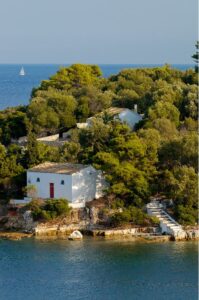 live presses working here.
live presses working here.
In 1797 the French took over the island, but only for 2 years until a Turkish/Russian siege was successful and Paxos became a “Septinsular Republic” with its own constitution. Seven years later it was back under French control, finally falling to the British fleet under Captain Richard Church in 1814 after a prolonged siege, partly aided by the Paxiots themselves, who, fed up with losing their olive trade, killed the island’s commander, Count Dimakis Makris. The French had briefly quelled the revolution and the ring leaders were given the ultimate punishment taken off the island in chains and shot in Corfu Castle. Final victory came when the Greek freedom fighter, Theodorus Kolokotronis stormed the fortress of St. Nikolaos.
The British ruled, in their inimitable and rather stern way, until 1864 when Paxos and the rest of the Archipelago were formally amalgamated with an independent Greece. From the middle years of the 20th Century onwards, the island has increasingly developed tourism, all the while maintaining its essential ambience of tranquillity and unspoilt scenery. Why don’t you stay at the Governor’s house, which was the official residence of the British governor when Paxos was a British Protectorate during the 19th century.
TOP BEACHES ON PAXOS
There are plenty of beaches to choose from, in fact you are spoilt for choice on this emerald, green isle, some of our favourites are:
Orkos Beach is less than half a mile from the pretty village of Lakka. Its turquoise waters gently brush over the white pebbles at this picturesque beach. Access is easy by car or on foot.
Mongonissi Beach is the little island at Paxos’ southern tip. It’s the islands only sandy beach and is great for families due to its many facilities, including sunbeds, water sports and a taverna. Access is by car.
Galazio Beach on the west coast is a small pretty shingle beach carved out of the cliffs and is only accessible by boat. Well worth a visit if only to see the colour of the sea which is truly Galazio (bright blue is the translation).
Avlaki Beach is another popular beach on the west coast, but access is via a steep 1km walk, alternatively by boat. Whilst it can be a tad rocky this beach is perfect for swimming, snorkelling and scuba diving.
Erimitis Beach is one of the most popular beaches on the island perhaps because of the exquisite scenery, azure waters with a backdrop of white cliffs breathtakingly stunning. At sunset it changes again when the commanding colours of orange and blue take over. The beach is a small pebbly one with access via a steep walk downhill.
Plani Beach sits under the watchful eye of Lakka’s lighthouse on the most north-western point on the island. Accessible by car, this pebbly beach is a great spot for watching the sun go down but do bring your swimming shoes for access. Not suitable for young children.
PAXOS CULINARY DELIGHTS
Memorable meals in dreamy settings must be one of the essential parts of a Greek holiday and this little gem of an island certainly serves up a fantastic menu of options for magical dinners under the stars. On Paxos you are certainly spoilt for choice with tavernas and restaurants not to mention their spectacular locations with some of the most heavenly views imaginable.
Plenty of choice of course in Gaios, Loggos and Lakka but also inland in the villages of Magazia, Fontana and Bogdanitkia (there might only be one or two tavernas in the villages, but they are certainly well worth seeking out).
Local specialities which are similar to Corfu (most likely due to its close proximity) are meat dishes such as Sofrito, beef cooked in wine with garlic and parsley, Pastitsada, a stew of chicken or veal with tomatoes, cinnamon and onions, usually served with pasta and Bourdeto a fish stew, with paprika, usually made with Scorpion fish, all well worth a try. It has to be said that a delicious meal is only as good as its ingredients and one of the specialities of the island is its Olive Oil made from the islands Lianolia olive, it’s so important to the island there is even a museum in Magazia dedicated to it.
Don’t forget to sample local Anti-Paxos wine, Paxo’s tiny neighbour some 3km to the south. White varieties include Asproudi, Lianorgo and Tsoukanarias. For full, smooth reds try Fidias or Petrokoryntho.
TOP PLACES TO VISIT IN PAXOS
LAKKA
Although a mecca for yachtsmen and windsurfers, Lakka is still very much a fishing village, as a meal at one of the local tavernas will attest. There are a few tavernas here and a small selection of shops, although there are also travel agencies that can change money for you and sell stamps and operate payphones.
LOGGOS
Considered by some as the prettiest of the three main villages of the island, the houses here are all painted in traditional pastel shades, and cluster around the head of a small horseshoe bay. The main thoroughfare passes along the waterfront and here chairs and tables from the different eating establishments spill out across the tarmac – a particularly Greek solution for the provision of extra covers! The surrounding hillsides, with their magnificent, gnarled olive trees and rows of cypresses, are well worth an hour or two’s gentle exploration.
DHENDHIATIKA
A small Venetian hamlet to the north of Levreichio Beach, Dhendhiatika can be reached up steps leading from the disused factory on the beach. The views are stunning from this point, however there is nowhere to buy refreshments, so make sure to take a bottle of water with you. You can also reach the village along the signposted road.
GAIOS
Situated on the eastern side of the island is the capital and main settlement, Gaios. It is a small low-rise town with several uninhabited forested isles in its bay. The town still has plenty of buildings with typical Ionian and Venetian architecture which unfortunately due to earthquakes no longer exist on other islands. You can relax on the harbour front people watching and looking at the various goings on the water before you whilst having a drink at the local café or Tav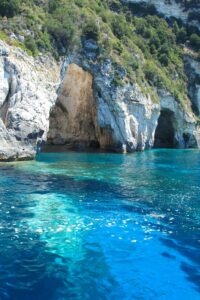 erna.
erna.
ANTIPAXOS
Regular boat services leave from all three of the island’s main villages to the tiny neighbouring island of Antipaxos. Famed for its stunning coves and excellent snorkelling, the island does get very popular with day trippers, especially in peak season, but it is well worth a visit – try heading south to avoid the crowds. There are three tavernas on the island but no shops or other facilities.
The sea caves are said to be some of the finest in the Ionian, and legend has it that an Allied submarine was even harboured here during World War II.
As well as independent travel to the island by sea taxi or caique, there are many round trip mini cruises from Gaios throughout the day.
FOLK MUSEUM
Gaios’ folk museum is situated in an old school building on the seafront about 200m south of the square. Exhibits include an 18th century bedroom containing period furniture and costumes, in addition to various items on display from different periods in history – ranging from musical instruments to guns and firearms.
The museum is open daily from 11.00am to 1.00pm and from 7.30pm to 10.30pm
MAGAZIA & ERIMITIS CLIFFS
Magazia village nestles beneath the island’s highest point at 248m. It is a small piece of civilisation in the wild grandeur of the Erimitis Cliffs, which fall in a vertiginous sweep of white limestone to the sea far below. There are picnic tables and benches here, and a short stroll down leads to an excellent viewpoint for the caves of Achai Bay – only accessible by sea.
Few would argue that a holiday on Paxos can be the perfect way to recharge the batteries or to escape from the demands of a busy world, but if a further boost is required then perhaps a visit to the Zoodochos Pigi church in Loggos with its frescoes from another age and its fountain might be in order. The name means Fountain of Life and will undoubtedly put a spring in your step for the short journey back to your accommodation!
We have a fabulous selection of properties for you to choose from, apartments with shared pools, villas for couples, large villas for families and even the delightful Paxos Club Hotel, something for everyone on perfect Paxos. Take your pick!
Do call us on 0208 459 0777 for more information on the carefully selected villas we have on Paxos or email us on: mail@ionianislandholidays.com
